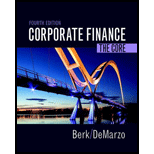
1)
To determine: The total return on the investment for one year in the risk-free investment and one year in the market.
Introduction:
Expected return refers to the return that the investors expect on a risky investment in the future.
2)
To determine: The total return on the investment for both years in the market.
Introduction:
Return is a loss or gain incurred on the investment made by the investors. It is expressed in terms of percentage.
a)
To determine: The highest expected final payoff from the both the strategies.
b)
To determine: The highest standard deviation for the final payoff from the both the strategies.
c)
To discuss: Whether the holding stocks for a longer period decrease the investor’s risk.
Introduction:
Risk refers to the fluctuations or movement in the value of an asset. The fluctuations can be positive or negative. The investor will be benefited by the positive price movement, and he will not be benefited by the negative price movement.
Want to see the full answer?
Check out a sample textbook solution
Chapter 10 Solutions
Corporate Finance: The Core (4th Edition) (Berk, DeMarzo & Harford, The Corporate Finance Series)
 EBK CONTEMPORARY FINANCIAL MANAGEMENTFinanceISBN:9781337514835Author:MOYERPublisher:CENGAGE LEARNING - CONSIGNMENT
EBK CONTEMPORARY FINANCIAL MANAGEMENTFinanceISBN:9781337514835Author:MOYERPublisher:CENGAGE LEARNING - CONSIGNMENT Intermediate Financial Management (MindTap Course...FinanceISBN:9781337395083Author:Eugene F. Brigham, Phillip R. DavesPublisher:Cengage Learning
Intermediate Financial Management (MindTap Course...FinanceISBN:9781337395083Author:Eugene F. Brigham, Phillip R. DavesPublisher:Cengage Learning
 Pfin (with Mindtap, 1 Term Printed Access Card) (...FinanceISBN:9780357033609Author:Randall Billingsley, Lawrence J. Gitman, Michael D. JoehnkPublisher:Cengage Learning
Pfin (with Mindtap, 1 Term Printed Access Card) (...FinanceISBN:9780357033609Author:Randall Billingsley, Lawrence J. Gitman, Michael D. JoehnkPublisher:Cengage Learning





